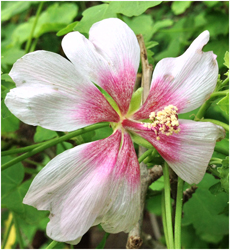Pollinator shifts are considered to drive floral trait evolution, yet little is still known about the modifications of petal epidermal surface at a biogeographic region scale. Here how independent shifts from insects to passerine birds in the Macaronesian Islands consistently modified this floral trait (i.e. absence of papillate cells) is investigated. Using current phylogenies and extensive evidence from field observations, a total of 81 plant species and subspecies were selected for petal microscopy and comparative analysis, including 19 of the 23 insular species pollinated by opportunistic passerine birds (Macaronesian bird-flowered element). Species relying on passerine birds as the most effective pollinators (bird-pollinated) independently evolved at least five times and in all instances associated with a loss of papillate cells, whereas species with a mixed pollination system (birds plus insects and/or other vertebrates) evolved at least five times in Macaronesia and papillate cells were lost in only 25% of these transitions. Findings suggest that petal micromorphology is a labile trait during pollinator shifts and that papillate cells tend to be absent on those species where pollinators have limited mechanical interaction with flowers, including opportunistic passerine birds that forage by hovering or from the ground. informacion[at]ebd.csic.es: Ojeda et al (2016) Pollinator shifts drive petal epidermal evolution on the Macaronesian Islands birdflowered species. Biol Lett 12, 20160022
http://rsbl.royalsocietypublishing.org/content/12/4/20160022  Latest News
Latest News
 Las altas temperaturas están provocando que las lagunas y las marismas de Doñana pierdan agua rápidamente
Las altas temperaturas están provocando que las lagunas y las marismas de Doñana pierdan agua rápidamente
La superficie inundada en la marisma es de un 78% pero la profundidad es escasa. Por otra parte, sólo el 1,9% de las lagunas temporales están inundadas. Las precipitaciones crean una oportunidad...
 Traffic noise causes lifelong harm to baby birds
Traffic noise causes lifelong harm to baby birds
A study with CSIC participation reveals for the first time that car noise harms individuals throughout their lifetime even years after exposure
 Illegal wildlife trade, a serious problem for biodiversity and human health
Illegal wildlife trade, a serious problem for biodiversity and human health
A research team led by the Doñana BIological Station and the University Pablo de Olavide have detected wild-caught pets in 95% of the localities in the Neotropic and warns of the risk of zoonotic...
 Urbanization and loss of woody vegetation are changing key traits of arthropod communities
Urbanization and loss of woody vegetation are changing key traits of arthropod communities
Urbanization is favouring smaller beetle species and larger spider species with greater dispersal capacity.
The loss of woody areas is linked to a decline in the duration of the activity...
The loss of woody areas is linked to a decline in the duration of the activity...
 Blood lead levels in an endangered vulture species decreased following restrictions on hunting practices
Blood lead levels in an endangered vulture species decreased following restrictions on hunting practices
Canarian Egyptian vulture was on the verge of extinction at the end of the 20th century. At that time, studies revealed that lead poisoning was a serious problem for the population’s survival. The...
— 5 Items per Page
 Asset Publisher
Asset Publisher
Back






